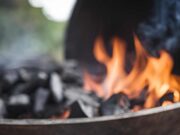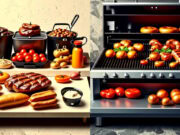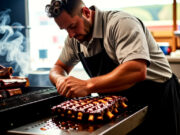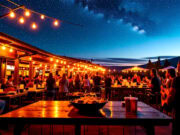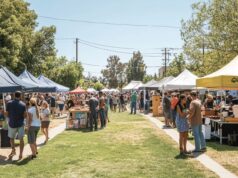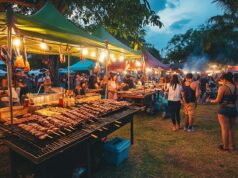Hosting a community BBQ is a great way to bring neighbors together, foster friendships, and enjoy delicious food in a relaxed atmosphere.
Whether you’re an experienced grill master or a first-time host, planning a successful event requires thought and preparation.
This guide offers essential tips, from choosing the perfect date and location to creating an inviting atmosphere and engaging your guests.
Get ready to fire up the grill and make lasting memories with your community!
Key Takeaways:
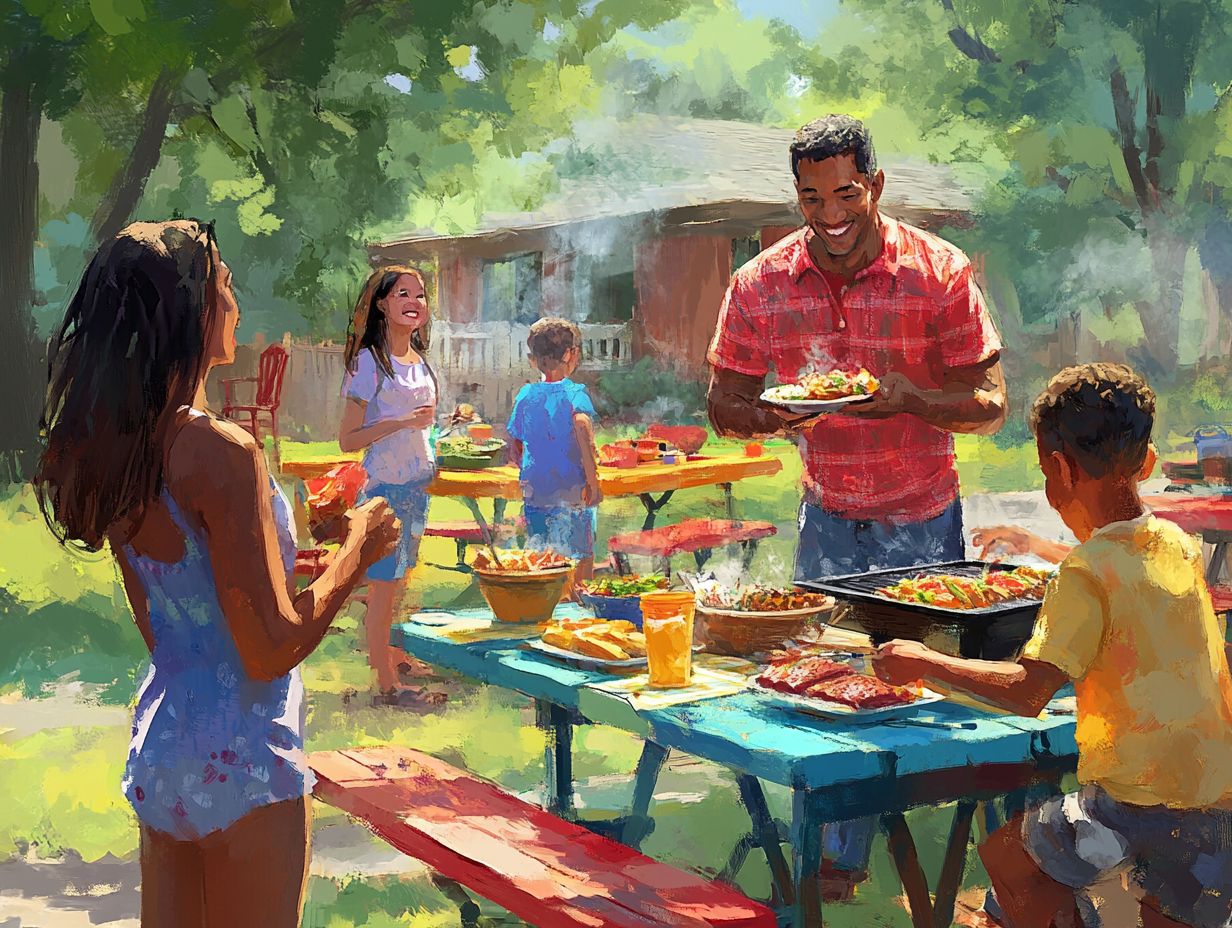
- Choose the right date, time, and location for your community BBQ to maximize attendance and ensure a successful event.
- Create an inviting atmosphere with a fun theme, comfortable seating, and shade to make your guests feel welcome and comfortable.
- Plan a delicious menu, cater to dietary restrictions, and set up a drink station for a well-rounded and satisfying dining experience at your BBQ.
How to Host a Successful Community BBQ: Tips and Tricks
Hosting a successful community barbecue transcends the mere provision of food; it involves fostering a sense of togetherness among attendees, facilitating engaging conversations, and savoring the pleasures of outdoor grilling.
With meticulous planning, one can create a memorable event that not only resonates with the community but also embodies the essence of this cherished American tradition. Whether the occasion is a Memorial Day barbecue, a graduation celebration, or simply a spring gathering, it is essential to consider various factors such as location, weather, and menu selection to enhance the overall experience for guests, ensuring they depart with both satisfaction and enjoyment.
Planning Your Community BBQ
The initial step in organizing your community BBQ involves selecting an appropriate date and time, ensuring that it aligns with local events and community calendars. This strategic approach will help maximize attendance and participation, transforming your BBQ into a significant occasion for all attendees.
It is advisable to consider holidays such as Memorial Day, Thanksgiving, and Super Bowl LV for themed BBQ events. Additionally, it is important to offer flexible options to accommodate guests with dietary restrictions.
1. Determine the Date and Time
Selecting the appropriate date and time for your community barbecue is essential for ensuring maximum participation and enjoyment among all attendees. It is important to consider local holidays and events that may impact availability.
For example, scheduling your barbecue on Memorial Day may result in a higher turnout due to the extended weekend, while organizing it around Halloween could introduce an enjoyable element with costumes and themed decorations. Conversely, neglecting to account for significant events, such as Super Bowl LV, may lead to diminished attendance, as guests may be conflicted between attending the barbecue and supporting their favorite team.
Additionally, it is prudent to consider seasonal weather patterns, as unfavorable forecasts, such as rain, could adversely affect your plans. To enhance the planning process, it may be beneficial to review AARP resources for potential discounts on catering or supplies associated with the event. This approach not only maximizes participation but also elevates the overall experience for all individuals involved.
2. Choose the Right Location
Selecting the ideal location for a community barbecue can greatly influence the atmosphere and overall enjoyment of the event. It is essential to prioritize accessible outdoor spaces that promote social interaction and enjoyment.
Various options should be considered, including local parks, community centers, or spacious backyards, each presenting unique advantages. Parks typically offer ample space for grilling as well as areas for recreational activities such as cornhole. Community centers may provide indoor alternatives, which can be particularly beneficial in the event of inclement weather.
Accessibility is of utmost importance; it is crucial to ensure that venues accommodate all guests, including those with mobility challenges. Additionally, having a contingency plan for unpredictable weather is advisable, as this may significantly impact the choice of location.
Organizations such as AARP may also assist in identifying suitable venues or offer event planning services, thereby enhancing the experience with their expertise.
3. Set a Budget
Establishing a realistic budget for your community barbecue is essential to ensure the provision of a diverse array of side dishes, snacks, and refreshments while avoiding overspending. It is advisable to take the time to plan and prioritize your expenses effectively.
Begin by estimating the costs associated with food, beverages, and equipment. Consider the types of meals to be served and the anticipated number of guests.
Regarding equipment, it is important to identify necessary items such as grills, serving utensils, and seating arrangements. Additionally, incorporating games and activities can enhance the atmosphere, so it is prudent to account for the costs associated with these elements as well.
Furthermore, it is beneficial to utilize AARP discounts on grilling tools and members-only products, as these can considerably reduce overall expenses.
Finally, it is crucial to anticipate unforeseen expenses—such as unexpected guests or equipment malfunctions—and develop a contingency plan to ensure the event proceeds smoothly without financial strain.
Creating an Inviting Atmosphere
Establishing an inviting atmosphere at a community barbecue has the potential to elevate a simple gathering into a memorable occasion. It is advisable to consider incorporating a cohesive theme, providing comfortable seating arrangements, and implementing engaging activities that foster social interaction among attendees.
4. Design a Fun Theme

Designing a thematic concept for a community barbecue not only serves as an effective icebreaker but also enhances the overall experience for attendees, encouraging active engagement and participation.
For instance, a tropical smokehouse theme can transport participants to a serene island paradise through the use of vibrant decorations such as tiki torches, palm leaves, and colorful tablecloths. Accompanying these visuals with a thoughtfully curated playlist featuring beach-inspired music will contribute to a relaxed ambiance.
Alternatively, for those who are enthusiastic about Super Bowl LV, a sports event theme can create an exhilarating atmosphere, characterized by decorations in team colors and activities centered around football trivia and mini-games.
Inclusivity is paramount; therefore, utilizing resources from organizations like AARP can provide tailored ideas that cater to diverse age groups and interests, ensuring that all guests feel welcomed and motivated to partake in the festivities.
5. Prepare Your Space
Properly preparing the space for a community BBQ is essential for fostering a pleasant environment for guests. It is important to allocate sufficient time for cleaning, setup, and the arrangement of all necessary equipment.
Begin by conducting a thorough cleaning of the cooking and dining areas, ensuring that debris is removed and surfaces are wiped down to create a welcoming atmosphere. Careful consideration of the layout is imperative; the grill should be positioned in an accessible location, away from foot traffic, while still allowing guests to mingle comfortably.
Food stations should be organized with clear signage to facilitate easy access to all culinary offerings, enabling guests to serve themselves without congestion. To promote interaction, seating should be arranged in a circular or clustered formation, encouraging conversation and engagement among attendees.
Additionally, essential items such as condiments, napkins, and cleaning supplies should be easily accessible, with a designated area for refills to maintain cleanliness and enhance the overall experience.
6. Provide Comfortable Seating and Shade
Providing comfortable seating and adequate shade at community barbecues is crucial for promoting relaxation and enjoyment among guests throughout the event.
With a variety of seating options available, including sturdy benches, picnic tables, and portable folding chairs, hosts can accommodate different preferences and group sizes. Each type of seating contributes to a distinct atmosphere, allowing guests to select their preferred level of comfort.
Additionally, strategically placed tents or umbrellas offer essential protection from the sun, enhancing the overall ambiance as attendees savor their meals and engage in stimulating conversations. By ensuring access to these amenities, hosts can create a more vibrant social atmosphere that encourages meaningful interactions and fosters connections among participants.
Menu Preparation
A well-conceived menu is fundamental to the success of any community barbecue, as it not only provides nourishment for guests but also demonstrates the effort and consideration invested in creating a pleasant experience for all participants.
7. Plan the BBQ Menu
Crafting a BBQ menu that captivates guests is essential for a successful community gathering. It is advisable to explore a variety of delectable options, including grilled meats, appealing side dishes, and refreshing beverages.
When planning the menu, one should consider incorporating diverse grilling techniques to enhance flavors and textures, drawing inspiration from esteemed establishments such as Famous Dave’s, recognized for its smoky ribs, and Tropical Smokehouse, noted for its tropical marinades.
An array of meats, including tender brisket, spicy sausages, and succulent chicken, should be featured. Additionally, it is important to accommodate varied dietary preferences by including vegan options such as grilled vegetable skewers or portobello mushrooms.
To complement these main dishes, a balanced selection of sides is recommended, including:
- Coleslaw
- Corn on the cob
- Baked beans
Providing enticing snacks, such as chips and dips, can facilitate socializing among guests.
To address guests’ thirst, a variety of refreshing beverages should be offered. Finally, concluding the meal with desserts like fruity tarts or ice cream will enhance the overall dining experience.
8. Cater to Dietary Restrictions
Catering to dietary restrictions when planning a community barbecue is essential for promoting inclusivity and ensuring that all guests feel welcome and satisfied with the available meal options.
By taking the time to inquire about guests’ dietary needs, hosts can provide a diverse menu that accommodates various preferences, including gluten-free, vegan, or nut-free options. This approach not only demonstrates consideration for all attendees but also ensures that no guest is left hungry or feels excluded from the meal. For instance, incorporating a hearty quinoa salad or grilled vegetable skewers alongside traditional burgers can offer delicious alternatives that appeal to everyone.
Additionally, clearly labeling food items can assist guests in making informed choices, thereby enhancing their overall experience and contributing to a more enjoyable gathering for all.
9. Set Up a Drink Station
Establishing a designated drink station at your community BBQ is an effective strategy for keeping guests refreshed and hydrated while enhancing the overall flow of the event.
This station can offer a delightful assortment of beverages, including refreshing cocktails, carbonated soft drinks, and a generous supply of ice-cold water to satisfy thirsts on a warm day. To facilitate easy access, it is advisable to organize the drinks using coolers or drink dispensers that can accommodate ice and maintain the beverages at a chilled temperature.
Additionally, pairing drinks with a selection of appetizing snacks, such as chips, dips, and fresh fruit, can elevate the overall experience by allowing guests to enjoy complementary flavors. It is also beneficial to incorporate unique mixers and garnishes, including fresh herbs, citrus slices, or decorative straws, to surprise and delight your visitors, ultimately making the drink station both functional and festive.
Grilling and Serving Tips

Mastering the art of grilling and serving at community barbecues can significantly enhance the culinary experience for guests. Therefore, it is essential to understand fundamental cooking techniques and to utilize appropriate grilling tools to ensure a successful event.
10. Ensure Your Grill is Ready
Before initiating the grilling process for your community barbecue, it is essential to take the necessary steps to ensure that the grill is adequately prepared to avoid any complications during cooking and serving.
Begin by conducting a thorough cleaning of the grill, ensuring that all residue from previous cookouts is removed. This practice not only promotes hygiene but also prevents any unwanted flavors from contaminating the food.
Next, verify the fuel levels, whether utilizing propane or charcoal, to ensure an adequate supply for the entire duration of the grilling session. Additionally, it is prudent to gather all essential grilling tools, such as spatulas, tongs, and grill brushes, so that they are readily available when needed.
Preheating the grill is a critical step, as it facilitates the attainment of the desired cooking temperatures and contributes to achieving those ideal grill marks. Familiarity with various cooking techniques—such as direct and indirect heat—will enhance the preparation of diverse dishes, ensuring that meats remain juicy and vegetables are perfectly charred.
11. Create Topping and Snack Stations
Establishing topping and snack stations provides guests with the opportunity to personalize their meals, adding an engaging and interactive dimension to the community barbecue experience.
By offering a diverse array of options, including various sauces such as tangy barbecue, zesty ranch, and creamy garlic, guests can customize their grilled items to align with their individual flavor preferences. Complementing these sauces with fresh vegetables, such as diced tomatoes, crisp cucumbers, and colorful peppers, can significantly enhance each dish. Incorporating garnishes like chopped herbs, crunchy onions, or jalapeños can further enrich the culinary experience.
Additionally, it is advisable to set up snack stations featuring appetizers and finger foods, such as sliders, veggie platters, and cheese boards, to promote mingling and casual snacking. This approach not only keeps all attendees engaged but also allows for enjoyable flavor combinations as guests create their ideal bites while socializing.
Engaging Your Guests
Engaging guests during the community BBQ is essential for fostering a vibrant atmosphere, ensuring that all attendees feel included and connected throughout the event.
12. Plan Fun Activities and Games
Planning engaging activities and games for a community barbecue can significantly enhance guest participation and ensure that all attendees have an enjoyable experience while socializing and appreciating the outdoors.
To foster a vibrant atmosphere, it is advisable to incorporate a variety of activities, such as cornhole, frisbee games, and friendly team competitions, which can promote camaraderie among participants.
Establishing designated areas for these activities is relatively straightforward; it requires careful planning and efficient space management. For cornhole, a few boards can be set up on a grassy area, while a designated field can be allocated for frisbee tosses.
It is essential to invite guests of all ages to participate by providing clear, easy-to-understand rules and offering small prizes for winners, which can encourage a spirit of friendly competition. By ensuring that everyone feels welcome and included, the barbecue can evolve into a delightful occasion filled with enjoyment and meaningful connections.
Final Touches
Incorporating the final details into your community barbecue can elevate a casual gathering into a festive celebration. It is important to pay attention to elements such as lighting and music, as these factors significantly enhance the overall atmosphere.
13. Consider Lighting and Music
Appropriate lighting and music can significantly enhance the atmosphere of a community BBQ, creating a more festive and inviting environment for all attendees.
There are various lighting options to consider that not only illuminate the space but also foster an ambiance conducive to social interaction and enjoyment. Solar lights represent an eco-friendly choice, charging throughout the day and providing a gentle glow as evening descends. Alternatively, tiki torches can introduce a tropical flair while offering warmth and rustic charm.
For those aiming to cultivate a cozy atmosphere, string lights can be draped above dining areas or seating arrangements, casting a romantic twinkle over the gathering. To complement this thoughtfully designed atmosphere, selecting an appropriate playlist that aligns with the BBQ’s theme and resonates with the diverse preferences of attendees will ensure that all guests feel included and engaged in the festivities.
14. Send Guests Home with Favors

Providing guests with thoughtfully curated party favors is an excellent method to convey appreciation and create lasting memories from your community barbecue.
These small tokens of gratitude not only enhance the overall experience but also cultivate a deeper connection among attendees. For instance, offering homemade snacks such as spiced nuts or barbecue-themed cookies can delight their taste buds while serving as a reminder of the enjoyable day spent together.
Moreover, consider gifting practical items such as branded spatulas or decorative condiment dispensers, which enable guests to recreate a portion of the event in their own backyards. By presenting such mementos, hosts can ensure that the joy and camaraderie of the gathering resonate with their friends and family long after the grill has cooled.
Frequently Asked Questions
What are some tips for choosing a location for a community BBQ?
The most important thing to consider is the size of the location. Make sure it can comfortably accommodate all attendees and has enough space for food prep and cooking. It’s also a good idea to choose a location with access to restrooms, parking, and shade.
How can I ensure there is enough food for everyone at the BBQ?
Start by estimating how many people will be attending, and then plan for a little more to be safe. Encourage guests to bring a dish to share to help supplement the food. You can also consider asking for donations or setting up a small entrance fee to cover the cost of food.
What are some fun activities to include at a community BBQ?
There are endless possibilities for activities! Some popular options include lawn games like cornhole or ladder ball, a piñata for the kids, a photo booth with props, or a raffle with donated prizes. Consider the demographic of your attendees and plan activities accordingly.
How can I make sure the BBQ is welcoming and inclusive for everyone?
It’s important to consider the dietary restrictions and preferences of your guests. Offer a variety of food options, including vegetarian and vegan options. Also, make sure to provide enough seating and accessibility for those with mobility issues. Consider having a designated area for those who may not want to be around smoke from the grill.
What are some safety precautions to take when hosting a community BBQ?
Always have a designated person in charge of grilling to avoid any accidents. Make sure to have a fire extinguisher nearby and follow proper food handling and cooking practices. Keep an eye on children and pets to ensure everyone’s safety.
How can I get the word out about the community BBQ and increase attendance?
Spread the word through various channels, such as social media, flyers, word of mouth, and local community newsletters. Collaborate with other local organizations to reach a wider audience. You can also offer incentives, like a free raffle ticket, for those who bring a friend to the BBQ.












